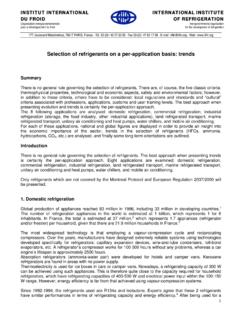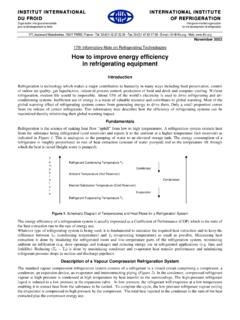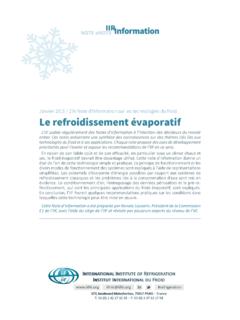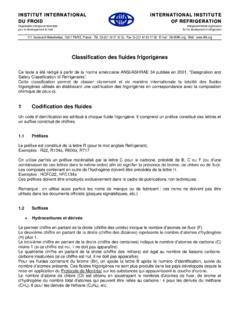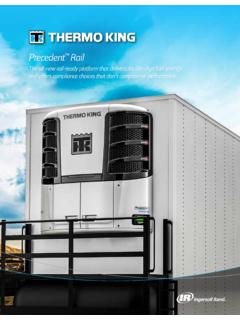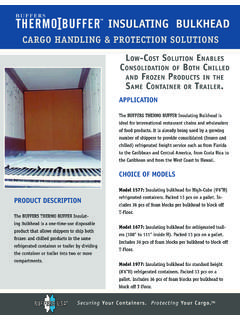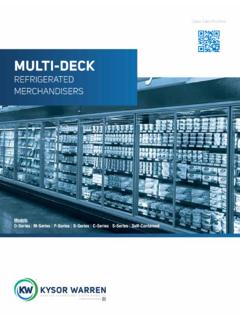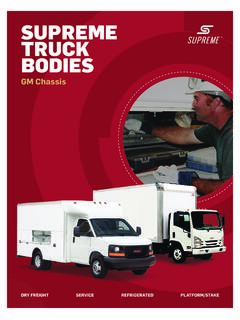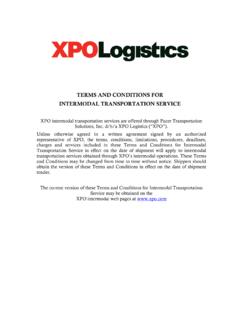Transcription of 21 Informatory Note on Refrigerating Technologies
1 21st Informatory Note on Refrigerating Technologies Introduction refrigerated transport is an essential link in the cold chain and aims to supply the consumer with safe, high-quality perishable goods. The goods concerned are perishable foodstuffs or non-food goods such as pharmaceuticals, flowers, plants, works of art, chemical products, etc. Frozen goods are transported at a temperature of 18 C or lower, chilled goods at a temperature above the freezing point. Some goods are also transported at controlled temperatures above 15 C ( cocoa, coffee, flavours, certain fruit and vegetables, certain pharmaceuticals). Food transport refrigeration is a critical link in the food chain, not only in terms of safety by properly maintaining the temperature of the transported goods, but also through its impact on energy consumption or CO2 emissions.
2 One of the greatest issues in refrigerated transport is the high dependency on oil for both refrigeration and motion purposes. refrigerated transport equipment has been progressively improved over the past 60 years in line with the development of food trade worldwide. Distances between production areas and consumers are increasing. A large amount of goods is transported from the southern to the northern hemisphere and vice versa, in order to benefit from seasonal production. Even if such exports are now criticized in some cases, transport activities will continue to expand. Currently, there are around 4 million refrigerated vehicles in service worldwide, including vans (40%), trucks (30%), semi-trailers or trailers (30%).1 According to a recent study,2 global road freight transport is expected to grow per year until 2030.
3 This clearly illustrates the importance of refrigerated transport worldwide. In addition, temperature-controlled pharmaceutical freight is expected to grow more than 20% per year. In order to keep pace with this expansion without raising its impact on the environment, the refrigerated transport sector will have to meet several scientific and technical challenges, with a focus on vehicle design, Refrigerating equipment, refrigerant issues, food safety and management and logistic Vehicle design optimization Even though vehicle energy consumption has been significantly reduced over the past 20 years, there are still opportunities for further improvement, in particular as far as refrigerated equipment is concerned. In order to address the challenges of environmental performance and sustainability, innovation is being introduced to refrigerated road transport in several directions.
4 Inspiration is often derived from other refrigeration fields then adapted to transport, which has unique features and requirements. Insulation: the search for better insulation focuses on the thermal conductivity of materials. With changes in foam-blowing agents over the past 10 years, the quality of insulation for refrigerated bodies has deteriorated somewhat. New insulation materials such as new types of foams, vacuum panels and aerogels have recently appeared on the market. Their application in refrigerated transport needs to be tested. Insulation should also be improved by the use of sophisticated composite structures where protection from thermal radiation and reflection can improve the insulation characteristics. The reduction of thermal bridges should also be investigated, particularly in bulkheads.
5 Thermal losses: door openings are the main source of thermal losses in trucks, especially during delivery operations, and air losses from the body are known to be a major cause of energy inefficiency. In other refrigeration systems such as display cabinets or cold rooms, airflow systems or automatic doors are commonly used to reduce cold air losses. This experience should be adapted to refrigerated trucks in order to understand the efficiency gains that could be achieved. The joints used for insulated bodies have been improved, but there is still room for improvement in the closing of lateral doors and the ageing of joints for example. Multi-temperature equipment: multi-temperature equipment allows energy savings with the use of a single vehicle to deliver goods at different temperatures in the same operation to the same place.
6 For more than 15 years, their market share has been growing, and this technology represented 20% of in-use equipment and 30% of new equipment in France in The performance of this equipment can be improved further, and testing and sizing should be harmonized. Aerodynamics: more than 15% of the energy consumption of a truck can be caused by poor aerodynamics. refrigerated truck aerodynamics have remained unchanged or have regressed over the past few decades. The aerodynamics of refrigerated trucks could be improved along with inner air Reduction of the truck s air resistance should not reduce the air exchanges in the condensing unit. Colour: trucks, and especially the large surface area of their insulated bodies, are attractive for marketing and advertising purposes, but the colour and the type of external surface of the body can impact up to 40% on the energy consumption of the refrigeration Communication should help users find the right design for their advertising!
7 4 Refrigerating equipment developments The most common refrigeration system in use for refrigerated food transport applications today is the vapour-compression system powered by a diesel engine. The manner in which the refrigeration unit is run is the basis on which equipment in road vehicles is classified, as either "dependent" or "independent":5 independent (or self-contained, self-powered, diesel unit): equipped with an independent heat engine which runs the compressor, both on the road and during stops; dependent (or non-self-contained, vehicle powered): such equipment is generally dependent on the engine of the road vehicle. If the refrigeration compressor is driven directly by the vehicle s engine, the refrigeration capacity can fall when the vehicle slows down (in the city) and ceases completely when the vehicle stops, and the engine is off, when it is advisable to plug the refrigeration unit into the local supply area if the unit is equipped with an electric motor.
8 The link between vehicle engine speed and compressor speed can be modified by using up-to-date electric supply systems: vehicle engine electric generator static converter electric (hermetic) compressor. There is still room for improvement in vapour-compression systems,6 in the refrigerant used for instance, or the reduction of leakage, but research on alternative production systems (absorption, adsorption, etc.) is also necessary. Cryogenic systems7: the recent rapid increase in the price of diesel fuel has generated renewed interest in cryogenic systems, particularly for urban distribution. The system is autonomous and cooled by cryogenic coolants. Such equipment uses liquid nitrogen or CO2 as a cryogenic fluid that is sprinkled inside the insulated body or cools an evaporator in a semi-closed system, where evaporated gas is vented out of the refrigerated body.
9 It is also less noisy and cools transported goods faster than conventional equipment. More than 1000 vehicles equipped with such systems are in service in Germany and Sorption systems: new innovative solutions such as ad- or absorption cycles are being tested. In heat-driven refrigeration Technologies , absorption and/or adsorption, the conventional mechanical compressor of the common vapour-compression cycle is replaced by a thermal compressor and a These systems, even if they generally offer lower COPs, can use waste energy, thus reducing the environmental impact of the technology. Hybrid systems: the transport refrigeration systems of the future could also be hybrid systems. The types of system in the hybrid arrangement will depend to a large extent on the size of the vehicle and the type of distribution.
10 The increasing use of hybrid vehicles requires comparable or at least compatible refrigeration solutions. Phase-change materials (PCMs): refrigerant systems offer good temperature homogeneity and stability, even during delivery. Nevertheless, their market share has dropped considerably in recent decades. Energy storage with phase-change materials could certainly become increasingly important, particularly if the PCMs are charged using renewable energy. These materials, acting as heat reservoirs, could increase the efficiency of the refrigeration circuit because of their ability to store large amounts of energy and release or absorb it in the form of heat. The use of such a system could be valuable, especially when the system is not in operation (compressor turned off), but there is a requirement to cool a body down or to stabilize at a required temperature.
